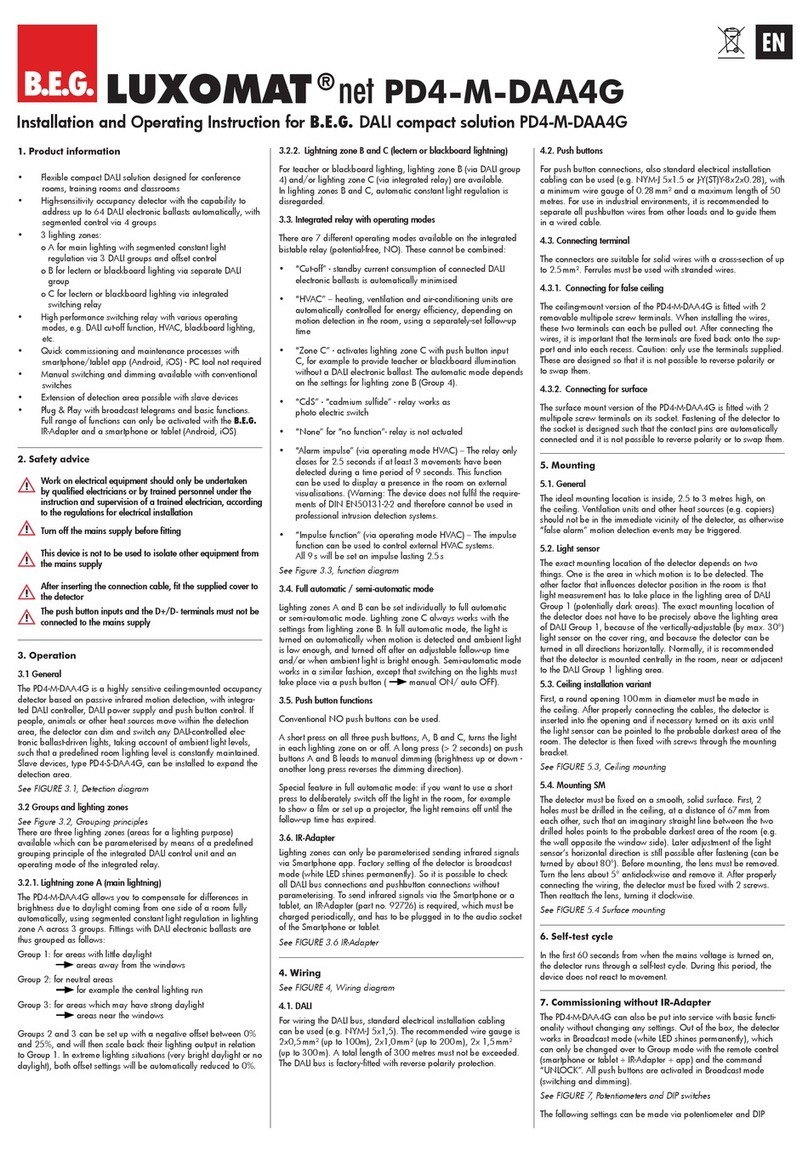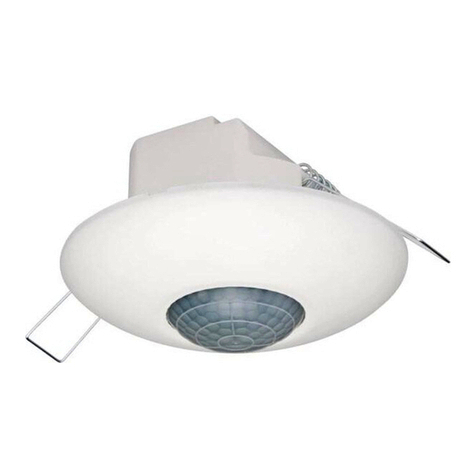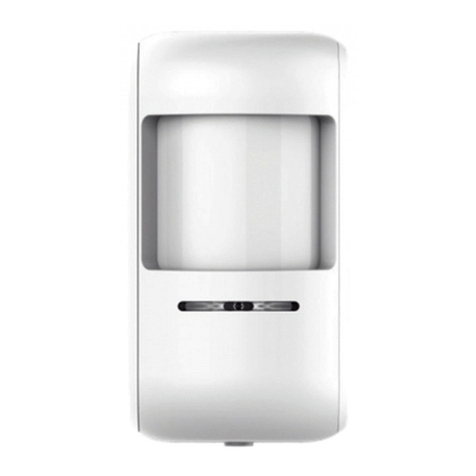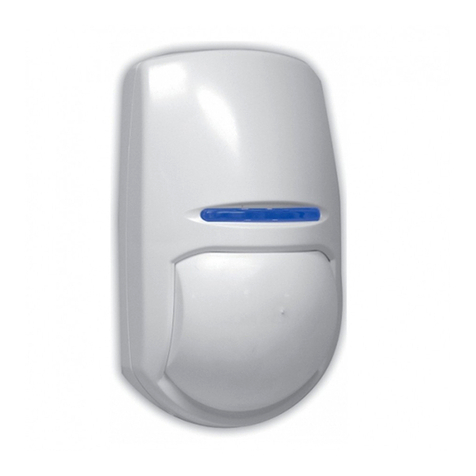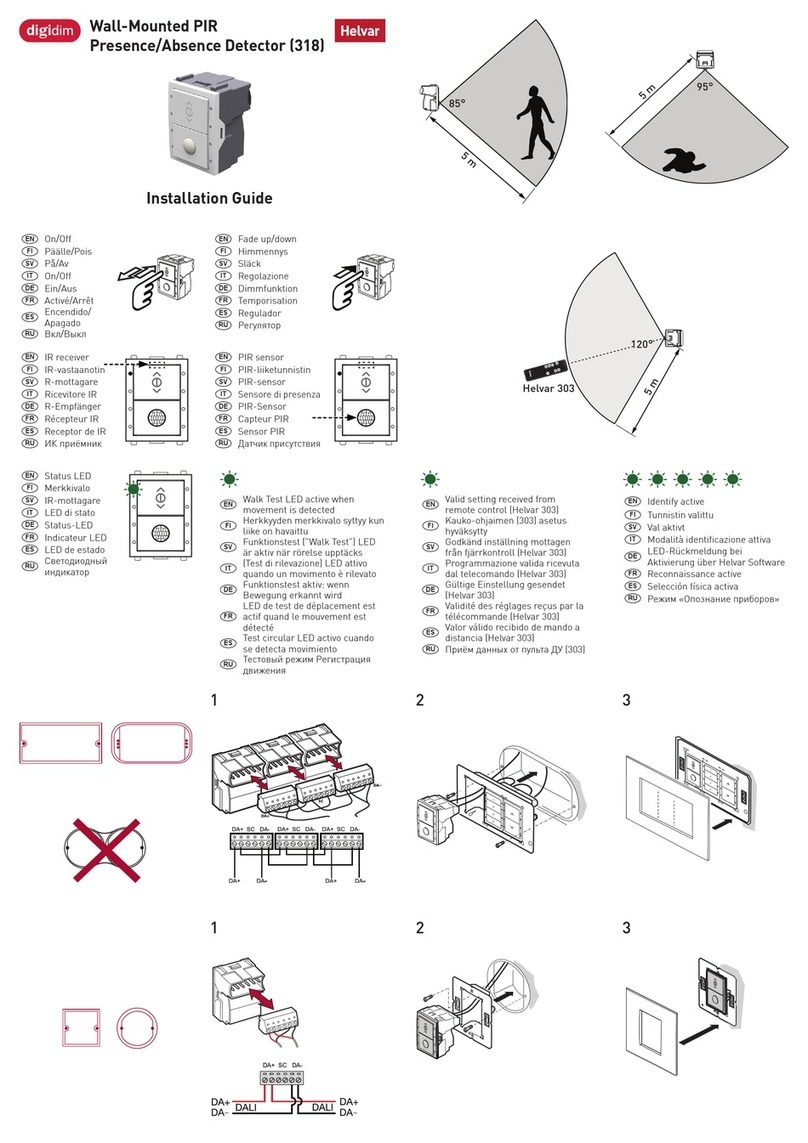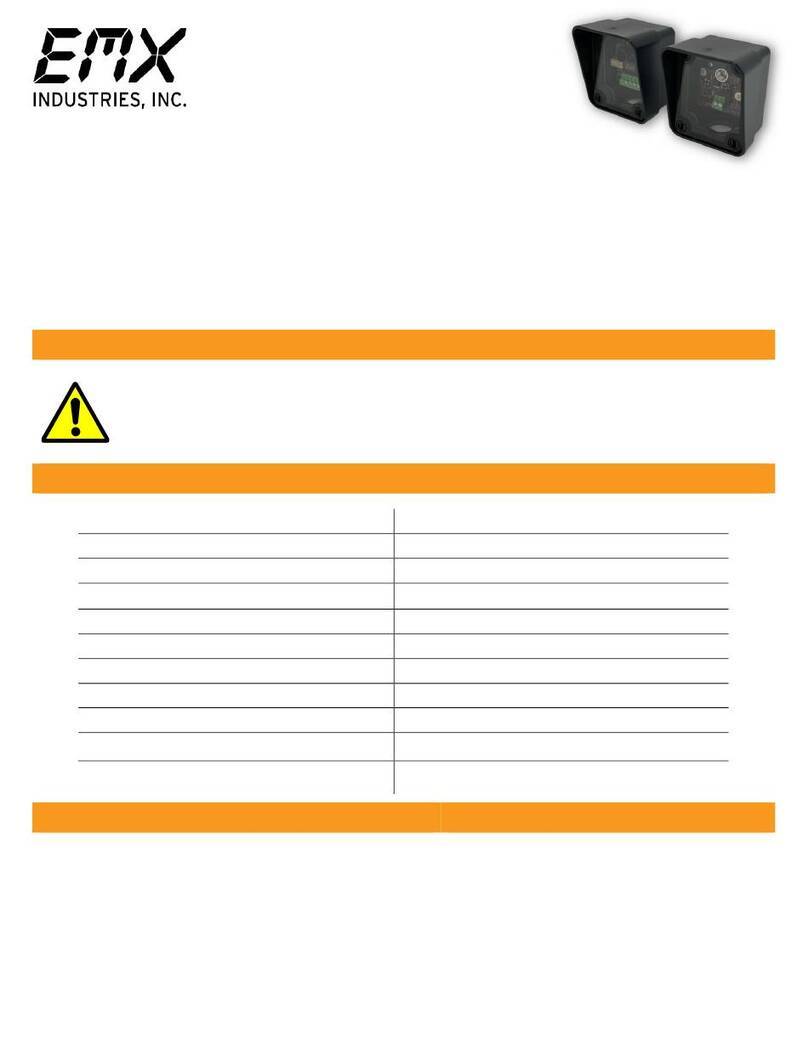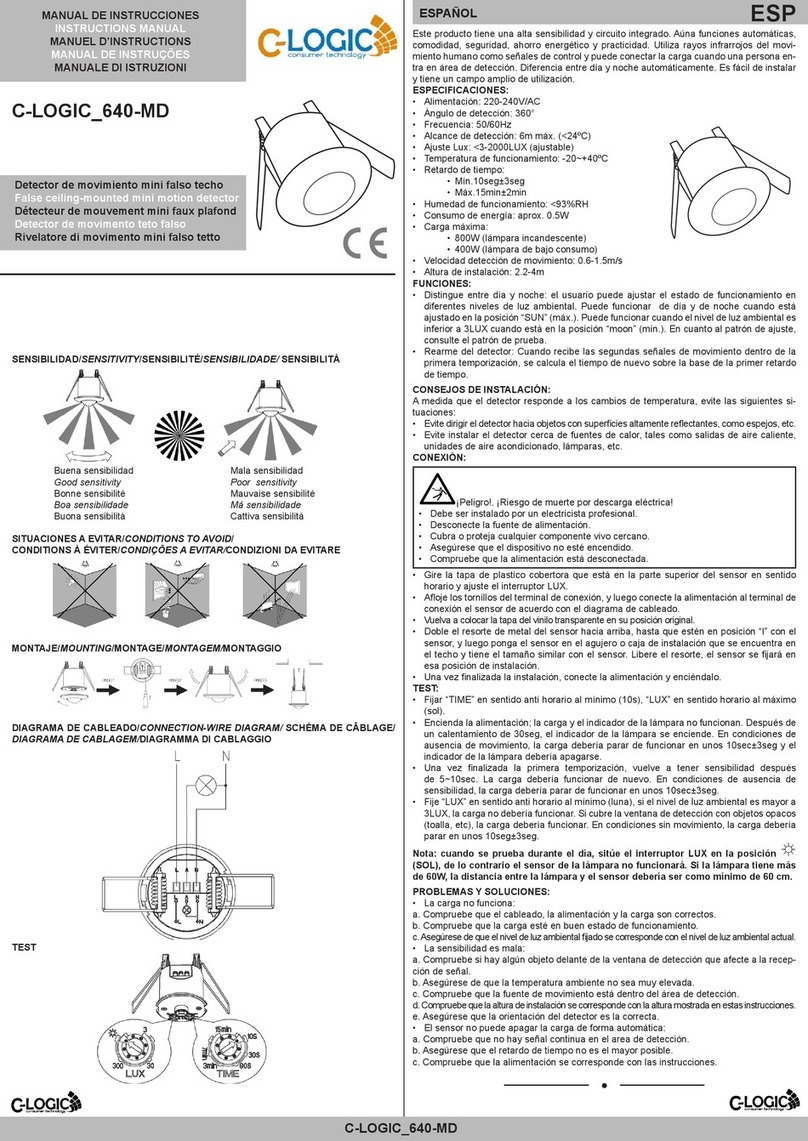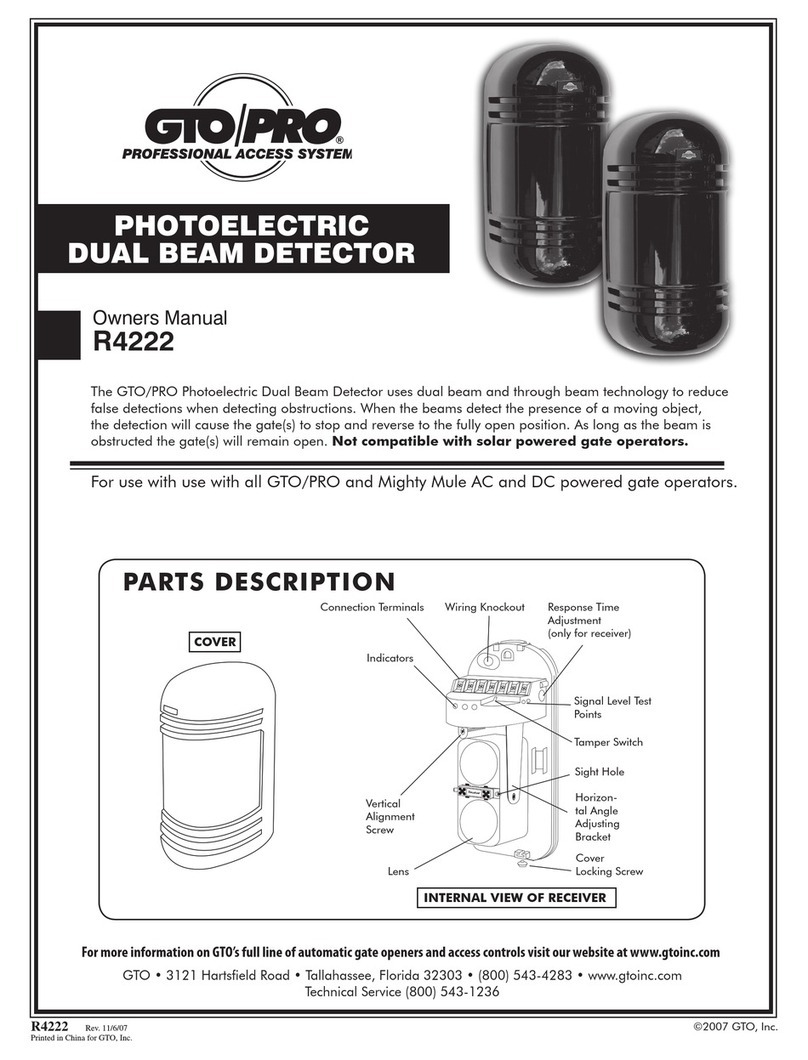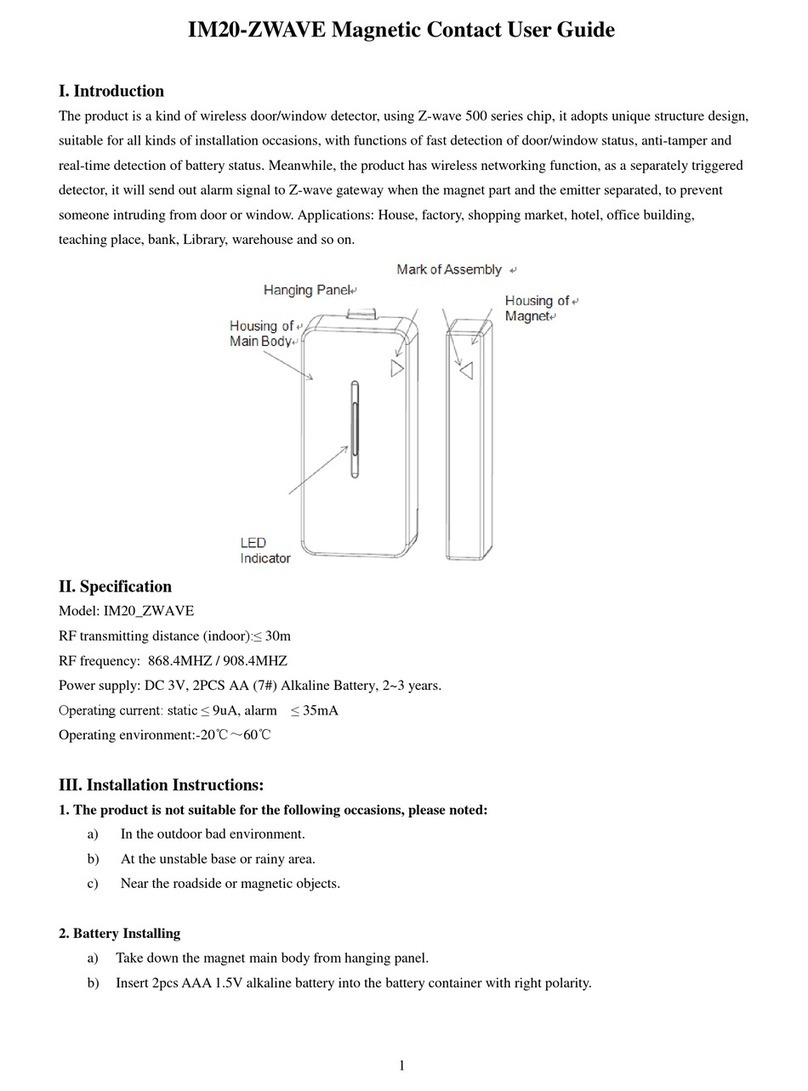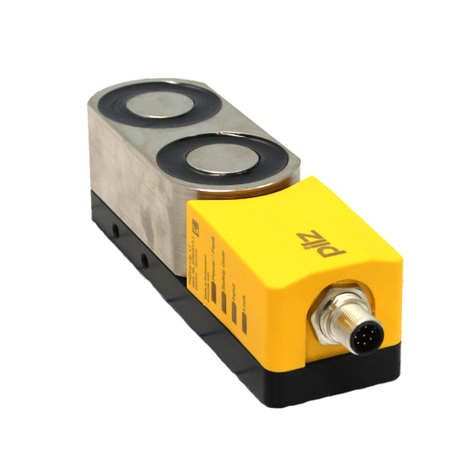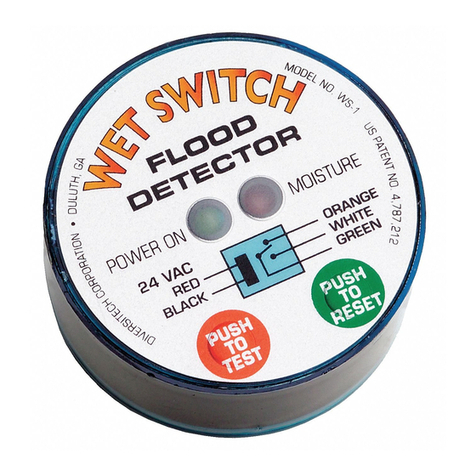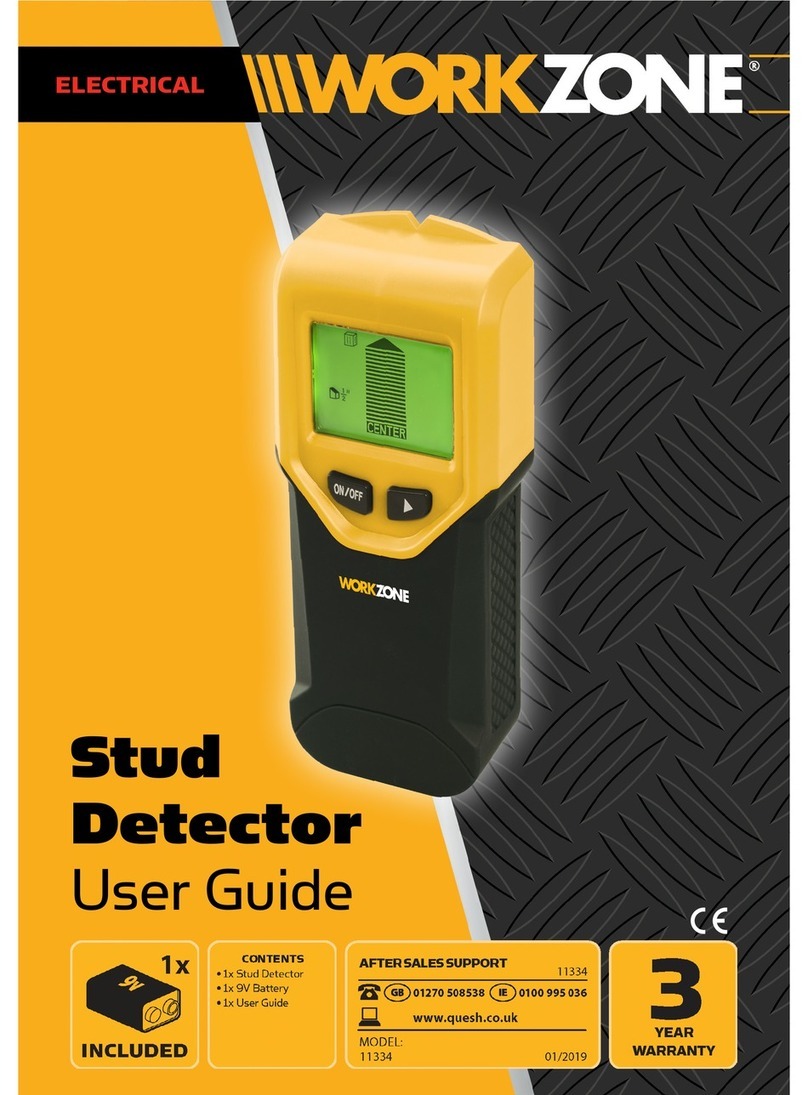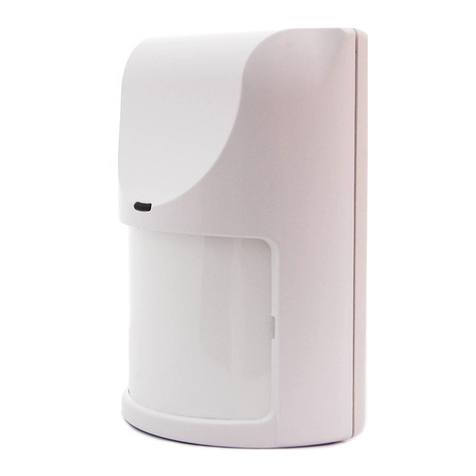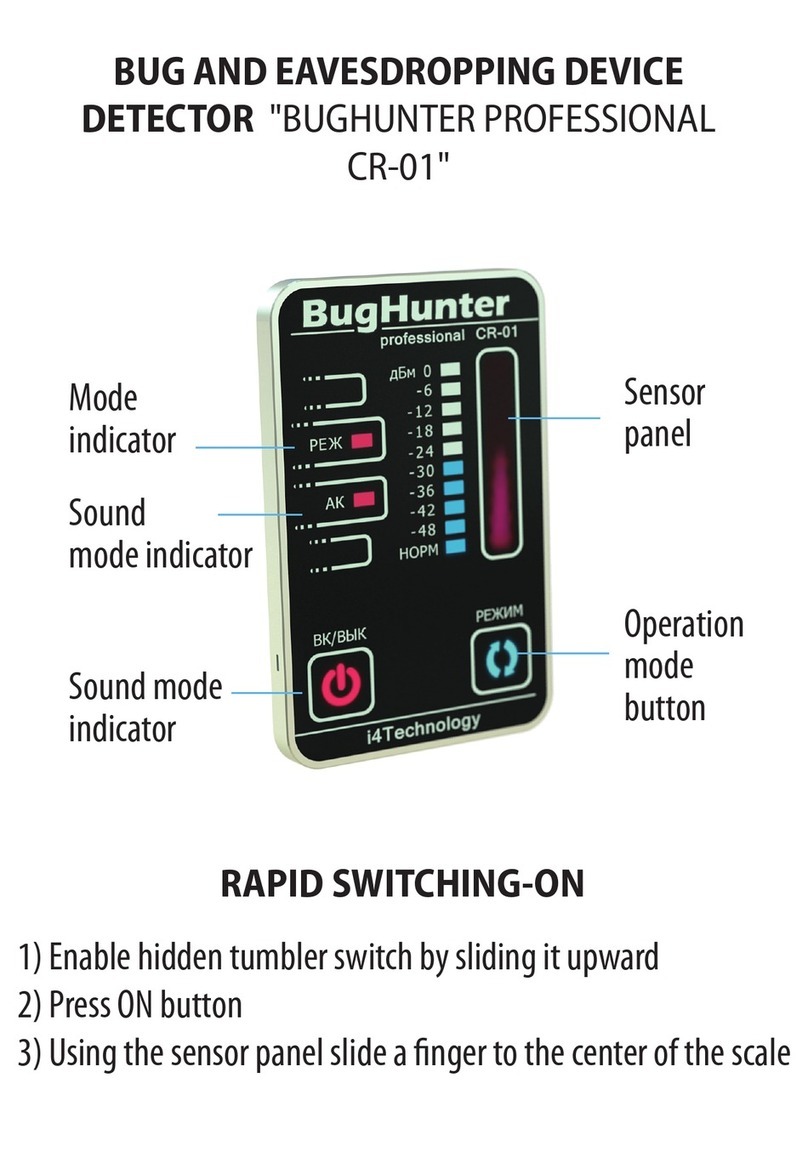Kemo Electronic B213 User manual

Infrared
light
barrier
max.
50m
Infrarot-Lichtschranke
max.
50m
Diese Lichtschranke hat mit der beiliegenden Optik und dem
hochempfindlichen Fotoempfänger eine rnax. Reichweite von
bis zu
50m!
Der Infrarot-Lichtstrahl ist für Menschen unsicht-
bar. Wenn der Lichtstrahl zwischen Sender und Empfänger
unterbrochen wird (wenn eine Person hindurchgeht), schaltet
das Relais
im
Empfänger.
With the enclosed optics and highly sensitive
photodetector
this light barrier has a max. range of up to
50m!
The infrared
light ray is invisible for men.
If
the light ray between the
transmitter
and
receiver
is
interrupted
(if
a person
wa/ks
through it) the
reiay
in the
receiver
switches.
Operating voltage:
transmitter:
9..12V=
approx.
70mA,
recei-
ver
12V=
approx.
100mA.
Relay contact:
1
x
Change
over 3A.
Gold-plated
board!
Price
cxoup:
10
Fittinq
case:
deutsch
/
english
/
espaiiol
/
franqais
/
nederlands
/
portuguk
/
suomalainen
DT-l
3
2
x
Kemo G027
/
\
1
4024028012131
IW
fl
http://www.
kemo-electronic.com
Betriebsspannung: Sender:
9..12V=
ca.
70mA,
Empfänger
12V=
ca.
100mA.
Relaiskontakt: 1 x UM 3A.
Platine
verqoldet!
Preisqruppe:
IO
deutsch
/
english
/
espafiol
/
fratqais
/
nederlands
/
portuguks
f
suomalainen
R31
2
Passendes
Gehäuse:
2
x
Kemo
G027
http://www.kemo-electroniccom

Infrarood
lichtsluis
max.
50
m
Deze
lichtsluis
heeft
met bijgesloten optiek en hooggevoelige
lichtontvanger een
maximaai
bereih van 50
meter!
De
infra-
rood
lichtstraal
is voor mensen onzichtbaar. Als
de
straal
tussen
zender
en ontvanger onderbroken wordt (als er
een
persoon doorheen gaat),
schakelt
het relais in de ontvanger.
Voedingsspanning:
zender:
9
-
12 V
=
bij 70 mA; ontvanger: 12
V
=
bij
100
mA Relaiskontakt: 1 x
OM
3 A.
Infrar>unavaIoveräjä
maks.
50m
I
Tämän
valoveräjän
kantomatka on sarjaan kuuluvan optiikan
ja erittäin herkän vahvistimen ansiosta jopa
50m!
Infrapu-
nasäde on
ihmissilmälle
näkymätön. Kun valosäde
Iähettimen
ja vastaanottimen väliltä katkeaa (henkilön liikkuessa sen Iäpi)
kytkee
vastaanottimessa sijaitseva rele.
Käyttöjännite:
lähettimen:
9...12V=,
n.
70mA,
vastaanotin
12V=,
n.
IOOmA.
Relekosketin:
1 x vk, 3A.
-
--
Piirilevy
kullattu!
deutsch
/
english
/
espafiol
l
franqais
I
Hintaluokka:
10
:
_
nederlands
l
portugubs
/
suomalainen
Sopiva
kotelo:
2
x
Kemo
G027
4024028012131
http://www.
kemo-electroniccom
http://www.kemo-electroniccom

Barri&e
infrarouge
max.
50
m
Avec
I’optique ci-jointe et
ie
photodetecteur
tres
sensible ce
barrage
photoelectrique
a
un rayon d’action maximal
jusqu’a
50 m! Le rayon infrarouge est invisible pour I’homme. Quand
Ie
rayon lumineux entre
I’emetteur
et Ie recepteur est
inter-
rompu (si une
personne
traverse),
Ie
relais dans Ie recepteur
commute.
Tension
de
Service:
emetteur:
9...12V=,
env.
70mA,
recepteur ,
12V=,
env.
100mA.
Contact du reiais: 1 x inversion 3A.
Platine
dorke!
deutsch
/
english
/
espatio
/
francais
1
Gioupe
de
prix:
IO
nederlands
/
poriugues
/
suomalainen
A
Baitier
recommandh:
[
2
x
Kemo
G027
4C24028012131
http://www.
kemo-eIectronic.com
5arrera
de
luz
infrarroja
max.
50m
Con Ia
optica
adjuntada y
el
fotodetector
muy sensible esta
barrera
de
Iuz tiene un alcance
m6ximo
hasta aprox. 50m. El
rayo
de
iuz
infrarroja es invisible para hombres. Cuando
se
interumpe
el
rayo
de
luz entre
el
emisor y receptor (cuando
una persona atravesa),
el
relais en
el
emisor conmuta.
Tension
de
servicio: emisor:
9...12V=,
aprox.
70mA,
receptor
12V=,
aprox.
100mA.
Contacto
de
rele:
1 x conmutar 3A.
iPli3Ca
dorada!
deutsch
/
english
/
espaiiol
!
franqais
!
nederlands
/
portugub
/
suomalainen
Grupo
de
precios:
IO-
-
-
-
-
Caja
pertinente:
2
x
Kemo
G027
w
3x-l
5
http://www.kemo-eIect.ronic.com

!
,
,
>
>
I
lnfravermelha
barreira
Mminosa
maximo
50m
Esta barreira luminosa tem com a junta
optica
e o
senkivel
foto receptor um raio
de
alcance
maximo
at6
50 m! A
infraver-
melha barreira luminosa
e
para pessoas invisivel. Quando o
raio luminoso entre o emissor e o receptor for interrompido
(quando uma pessoa o atravessar) liga o
rele
no receptor.
Tensäo de
servico:
emissor:
9...12V=
cerca
70mA,
receptor
12V=
cerca
100mA.
Rele
contacto: 1 x comutador
3A.
Placa
dourada!
Grupo
de
precos:
10
deutsch
/
english
/
espafiol
/
franqais
/
derlands
/
porluyu~s
/
suomalainen
Caixa
adesuada:
2
x
Kemo
G027
4024028012131
’
Empfänger
Sender
transmitter
http://www.
kemo-electronic.com
http://www.
kemo-electronic.com

,
9
-
R7
*
Tl
c7
-.
_
LED1
Sender
Transmitte
Rl
Em
R5
R9
T3
.
lens
C6 Linse RE
c-7
\
t
IF
t,
LED
Receiver
8
i
\
c4
IC
CS
c3
c2
D
/
STÜCKLISTE
/
SENDER:
LEDl,LED2
:
2 Infrarotdioden TSHA 5201
Tl,T2
:
2 Transistoren SS 219 oder BC 547
T3
:
1
Transistor SF 828 E oder BC
337/40
R5
:
1 Widerstand 15
Ohm
1W
(15R)
R6,R8
:
2 Widerstände 10 k (braun-schwarz-schwarz-rot...)
R7
:
1 Widerstand 22 k (rot-rot-schwarz-braun...)
R9
:
1 Widerstand lkl (braun-schwarz-braun-braun...)
c-7
:
1 Elko
1001~F
16V
C8
:
1 Kondensator
100nF
(104)
C9,ClO
:
2 Kondensatoren
4,?‘nF
(4n7)
1 Platine, ca. 17 x 55 mm
STÜCKLISTE
/
EMPFÄNGE-
Rl,R4
:
2 Widerstände 680 Ohm (680R)
R2
:
1 Widerstand 150 k (braun-grün-schwarz-orange...)
R3
:
1 Widerstand lk05 (braun-schwarz-grün-braun...)
e
Cl,C5
C2,C4,ClO
:
:
2
3 Elkos Kondensatoren
1OvF
50V
82pF (82 K)
Q
c3
C6
:
:
1
1
ElkoKondensator
1OOpF
25V
100nF
(104)
C7
:
1 Kondensator 39pF (39p)
C8
:
1
Kondensator
4,7nF
(4n7)
C9
:
1
Elko
4,7uF
25V
IC
:llCU
2531
:
1 IC-Sockel
8-polig
IF
:
1 Infrarotdiode
LED
:
1
Leuchtdiode 5 mm orange
RE
:
1
Relais 1 x UM
12V
T
:
1
Transistor BC 308
1
Linse
1 Platine, ca. 56 x 45 mm
Beiliegendes
Extm!J~?t
rnlt
Sicherheitshinweisen
beachtenl

I
’
1
.’
,
GB
,’
PARTS LIST
/
TRANSMITTER:
LEDl,LED2
:
2 infrared diodes TSHA 5201
Tl,72
:
2 transistors SS 219 or
BC
547
T3
:
1 transistor SF 828 E or BC
337/40
R5
:
1
resistor
15
ohm
1W
(15R)
R6,R8
:
2 resistors 10 k
(brown-black-black-red...)
R7
:
1 resistor 22 k (red-red-black-brown...)
R9
:
1 resistor
lkl
(brown-black-brown-brown...)
c7
:
1
electrolytlc
capacitor
1OOpF
16V
C8
:
1
capacitor
100nF
(104)
C9,ClO
:
2 capactors
4,7nF
(4n7)
1 board, approx. 17 x 55 mm
PARTS LIST
/
RECEIVER:
Rl,R4
:2
R2
:l
R3
:l
Cl,C5
:2
C2,C4,ClO
:
3
c3
:l
C6
:l
C7
:l
C8
:l
c9
:l
IC
:l
:
1
IF
:1
LED
:l
RE
:1
T
:l
1 lens
resistors 680 ohm (680R)
resistor 150 k (brown-green-black-orange...)
resistor lk05
(brown-black-green-brown.
..)
electrolytic capacitors
10pF
50V
capacitors 82pF (82K)
ele&trolytic
capacitor
100pF
25V
capacitor
1OOnF
(104)
-
capacitor 39pF (39p)
capacitor
4,7nF
(4n7)
electrolytic
capacitor
4,7uF
25V
IC
U 2531
IC
socket
8-pole
infrared diode
light emitting diode 5 mm orange
relay 1 x
Change
over
12V
transistor BC 308
t
abgeflachte Seite
flattened side
/
/
/
abgeflachte Seite
flattened side
+
1 board, approx. 56
3
45 mm
10
11

14
1
l ,
I
D
/
Die beiden Platinen werden
gern%
Zeichnungen Seite
8
bestuckt.
Der
Fototransistor des Empfängers wird bis zum Anschlag
tn
die Platine
gesteckt
(bitte
die richtige Polarität beachten, die eine Seite des Fototransistors
ist
abgeflacht).
Die Linsenoptik wird
gemäf3
Zeichnung so auf die Platine geklebt,
da6
der
Fototransistor in der Mitte des Durchmessers der Linse liegt (im Brennpunkt).
Der Empfänger benötigt eine Betriebsspannung von
12Vz
(ca.
100mA)
und der
Sender ca.
9V=
(max. 70mA). Bitte verwenden Sie ausreichend starke
Gatterren
oder Netzteile! (Die kleinen
9V
Blockbatterien
sind
z.B
zu
sch\uach
und
nicht
geeignet!). Am besten verwenden Sie 2
stabrlisierte
Steckernetzteile mit je
9V=
und
12V=
Ausgangsspannung.
Um den Fototransistor vor
seitlichen
Lichteinfall zu schützen, muß
ein
Kunststoff-
oder Papprohr,
gemäR
Zeichnung Seite
15,
über die Optik geschoben werden
Das Rohr muß innen schwarz eingefärbt sein. Außerdem
muR
das Papprohr in
alle Richtungen den Lichteinfall verhindern, außer von vorne.
Der Sender muß dann so ausgerichtet werden,
daf3
er genau von
vorn?
durch das
schwarze Rohr auf die Optik strahlt.
Je weiter der Sender vom Empfänger entfernt wird,
umso
genauer muß der
7
Sender auf den Empfänger ausgerichtet werden. Wenn der
Sender
auf
den
‘F
/
Equ~p&
Ie\
deux
piatines
selon
les
dessins
page
8.
Inserez
Ie
phatotransistor’du
recepteur
dans
Ia
Platine
jusqu’a
Ia
butee
(veuillez
faire
attention
5
Ia
polaritd
corrocte.
une
face
du
phototransistor
est
aplatie).
Collez
I’optique
de
lentrlle
sur
Ia
Platine
selon
ie
dessin
de
maniere
que
Ie
phototransi-
stor
soit
au
centre
du
diametre
de
Ia
lentille
(dans
Ie
foyer).
ie
recepteur
a
besoin
d’une
tension
de
Service
de
12V=
(env.
100mA)
et
I%metteur
env.
9V=
(max.
70mA)
Veuilfez
ernployer
des
batteries
qui
sont
assez
pUiSSantes
ou
des
blocs
d’alimentation!
(Les
petites
batteries
monoblocs
9V
sont
trop
faibles
et ne
sont
pas
approprieesl).
Le
mieux
est
d’ctiliser
2
blocs
d’alimentation
de
Prise
avec
9V=
et
12V=
tension
da
sortie!
Pour
proteger
Ie
phototransrstor
contr,
a
I’incidence
laterale
de
Ia
lumiere,
il
faut
pousser
un
tuyau
en
plastique
ou
en
carton
sur
I’optique
selon
Ie
dessin
page
15.
II
faut
que
Ie
tuyau
soit
colore
noir
a
I’interieur
En
plus
Ie
tuyau
en
carton
doit
empechcr
I’incidence
de
Ia
lumiere
dans
toutes
les
directions,
sauf
par devant.
Ensuite
il
faut
ajuster
I’emetteur
de
faC;on
qu’il
rayonne
exactement
dans
Ie
tuyau
nOif
. . .
Empfänger trifft, leuchtet
die.Leuchtdiode
am Empfänger und das Relais schaltet
ein.
E
/
Dotar
las
dos
placas
de
circuitos
impresos
segun
los
dibujos
pagina
8.
Introducir
el
fototransistor
del
receptor
en
Ia
placa
de
circuitos
impresos
hasta
el
tope
(presrar
atencion
a
Ia
polaridad
correcta,
un
lado
del
fofotransistor
es
aplanado).
Pegar
Ia
optica
de
Ia
lente
sobre
Ia
placa
de
circuitos
impresos
segun
el
dibujo
de
manera
que
et
fototransistor
se
encuentre
al
centro del
diametro
de
Ia
lente
(en
el
foco).
El
receptor
necesita
una
tension
de
servicro
de
l2V=
(aprox.
100mA)
y
el
emisor
aprox.
9V=
(max.
70mA).
Por
favor.
utrlize
Vd.
baterias
con
potencia
suficiente
o
fuentes
de
alimenta-
cion
(Las
pequehas
baterias
monobloc
9V
son
demasiado
debiles
y
no
son
adecuadas).
Lo
mejor es de
utilizar
dos
fuentes
de
alimentocion
de
clavija
estabilizadas
con
9V=
y
12V=
tension
de
salida
respectivamente.
Para proteger
el
fototransistor contra
rncrdencia
de Iuz lateral.
se
debe
empujar
un’tubo
de
plastico
o
de
carton
sobre
Ia
eptica
segun
el
dibujo
Pagina
15.
Et
tubo
debe
ser
colorado
negro
al
interior.
Adern&
el
tubo
de
carton
debe
prevenir
Ia
incidencia
de
luz
en
todas
las
direcciones,
excepto
de
delante.
Entonces
se
necesita
ajustar
el
emisor
de
manera
que
radie
a
traves
del
tubo
negro
de
delante
sobre
Ia
optica.
Lo
mas
el
emisor
se
aleja
del
receptor,
Io
rnas
exacto
el
emisor
se
debe
alinear
al
12
receptor.
Cuando
el
emisor
choca
contra
el
receptor,
el
diodo
luminescente
al
receptor
emite
luz
y
el
rele
conecta.
,
i
par
aevanr
sur
I’oprique.
Le
plus
I’emetteur
est
eloign6
du
recepteur.
Ie
plus
exact
Gmetteur
doit
6tre
aligne
sc!r
Ie
recepteur.
Quand
I’emetteur
donne
contre
Ie
recepteur,
Ia
diode
&WdUtnine-
scente
au
recepteur
s’allume
et
Ie
relais
commute.
GB
/
60th
boards
have
to
be
tipped
according
to
the
drawings
page 8.
The
phototran-
sistor
of
the
receiver
is
rnserted
into
the
board
up
to
the
limit
stop
@lease
pay
attention
tc
the
correct
polanty.
one
side
of
the
phototransistor
is
flattened).
.9ccording
to
the
drawing
the
lens
optic
is
Stuck
an
the
board
in
such
a
manner
that
the
phototransistor
is
located
in
the
centre
of
the
diameter
of
the
lens
(in
the
focus).
The
recetver
requires
an
operatingvoltage
of
12V=
(approx.
100mA)
and
the
transmit-
ter
approx.
9V=
(max.
70mA).
Please
use
batteries
or
power
unrts
which
arc
powerful
enough
(the
small
9V
compound
batteries
are
too
weak
and
not
suitable!)
It
would
be
the
best
If
you
use
2
stabilized
connector
power
units
with
9V=
and
12V=
Output
voltage
each.
In
order-
to
protect
the
phototransistor
from
lateral
incidcnce
of
light,
a
piastic
or
cardboard
tube
must,be
slid
over
the
optics
according
to
the
drawing
page
15.
The
inside
of
the
tube
must
be
stained
black.
Furthermore
the
cardboard
tube
mUSt
prevent
the
incidence
of
Iight
from
all
directions
with
the
exception
of
the
front.
Then
the
transmitter
must
be
adjusted
in
such
a
manner
that
it
radiates
through
the
black
tube
on
the
optics
exactly
from
the
front.
The
greater
the
distance
from
the
transmitter
to
the
receiver,
the
more
exactly
the
transmitter
must
be
aligned
on
the
receiver.
If
the
transmitter
meets
the
receiver,
the
I
Irght
emlttmg
diode
at
the
receiver
lights
and
the
relay
switches
on.
13

NL
)
De
bei&e
printplaten moeten volgens de tekeningen
lzijde
S
LjrordRn
volgebouwd. De fototransistor van de ontvanger wordt
tot
aan
de
aanslag
in
de
printplaat gestoken. Let
a.u.b.
op de korrekte polariteit,
een
kant van
de
transistor is
vlak.
De lenzenoptiek worden volgens
tekenrng
zodanig
op de
printplaat
gep!akt,
dat
de fototransistor in het
midden
van de doorsnede van de optiek
kamt.
dus
in
het brandpunt.
De ontvanger wordt gevoed met 12 V
=
en
100 mA, en de
zender
met 9
V
=
en
max. 70 mA. Gebruik
a.u.b.
voldoende
Sterke
batterijen of adaptors! (De kleine
9 V blokbatterijen zijn bijv. te zwak en
dus
niet,
geschikt).
Het beste
gebruikt
u
2
i
gestabiliseerde adaptors met respectievelijk 9 V
=
en
12
V
=
ultgangsspanntng
i
Om de fototransistor
af
te
schermen
voor
licht
dat
van
de
zijd?n
invalt.
moet er
!
een
kunststof
of kartonnen
buis
volgens
de tekening zijde 15 over de optiek
geschoven
worden.D
e
buis
moet
van
binnen
zwart geverfd of geklaurd zijn.
I
Bovendien moet hij
de
lichtinval
van
alle
kanten
verhinderen,
behalve
van
voren.
De
zender
moet zodanig
opgesteid
worden
dat
hij
precies
van
voren
door
de
burs
in
de
optiek
straalt.
I
Hoe
verder
weg
de
zender
van
de
ontvanger
geplaatst
wordt,
hoe
preciezer
hij
(
op
de
ontvanger
afgesteld
moet
worden.
Als
de
zender
precies
op
de
ontvanger
1
straalt,
gaat
de
LED
op
de
ontvanger
aan.
en
schakelt
de
relais
in. i
P
/
As
duas
platinas
So
equipadas
tonforme
no
desenho
Pagina
8.
0
foto
transistor
do
receptor
e
montado
na
platrna
at6
ao
esbarro
(tomar
atencäo
na
polaridade.
un?
lado
do
transistor
e
chato).
1
A
lente
optica
6
assim
tonforme
no
desenho
colada
na
platina,
para
que
o
foto
transistor
I
fique
situado
no
meio
do
diametro
(no
ponto
focal).
.O
receptor
necessita
uma
tensao
de
servico
com
l2V=
(cerca
100mA)
e
o
emissor
cerca
9V=
(max.7OmA).
Usar
batarias
ou
pecas
de
rede
suficiente
fortes.
(As
pequenas
bloco
batarias
9V
s30
por
exp.
muito
fracas
e
nao
adequadas!).
i
melhor
usar
2
estabilizadas
pecas
de
rede,
cada
com
9V=
e
12V=
tensao
de
saida.
Para
proteger
G
foto
transistor
contra
lateral
Iuz
incrdente,
tem
tonforme
no
desenhc
Pagina
15
ser
um
tubo
plastico
ou
de
cartao
empurrado
sobre
a
optica.
0’
tubo
?em
no
interior
ser
tmgido
de
preto.
0
tubo
de
cartao
deve
evitar
a
luz
incidente
de
todas
as
direcöes
menos
pela
frente.
0
ernissor
tem
entäo
de
ser
ajustado,
para
que
este
pela
frente
atraves
do
tubo
preto
possa
brilhar
exatamente
na
optica.
Quant0
mais
Qistante
estiver
o
emissor
do
receptor,
entao
mais
exato
tem
o
emrssor
ser
ajustado
ao
receptor.
Quando
o
emisscr
acertar
com
o
receptor
entäo
brrlha
CJ
diodo
luminoso
no
receotor.
e
0
rele
entra
em
servico.
14
-
1
l
ia
L
I
FIN
/
Piirilevyt
kalustetaan
piirustusten
mukaisesti
sivu
8.
Vastaanottimen
valotransistori
tyonnetaan
piirrlevyyn
vasteeseen
asti
(tarkista.
että
napaisuus
on
oikea,
valotransistorin
toisessa
srvussa
on
suora
taso).
Linsseista
kcostuva
optiikka
liimataan
piirustuksen
mukaisesti
piirilevyyn
niin,
etta
valo-
transistort
srjoittuu
linssrn
halkaisijan
keskipisteeseen
(polttopisteeseen)
Vastaanotrn
tarvitsee
12V.n
käyttöjannitteen
(n.
100mA)
ja
Iähetin
n.
9V=
(maks.
70mA).
Gytä
tarpeeksi
tehokkaita
parlstoja
tai
verkkolaitteital
(Esim.
pienet
9V
‘neppariparistot’
ovat
liian
heikkoja
eivatkä
soveltu!)
Käytä
mieluiten
kaksi
stabiloitua
verkkolaitetta.
joiden
ulostulojannitteet
ovat
9V=
ja
12V=.
Valotransistorr
suojataan
srvulta
tulevalta
valolta
tyontämälla
muovi-
tai
pahviputki
optiik-
kaan
piirustuksen
mukaisesti
sivu
15.
Putken
sisäpinnan
tulee
olla
mustaksi
värjätty.
‘L’IS”dk$I
lu’t~e
p’Lwer1
ESA
tl
mw
px?Iqn
WhSCtr
\nu~svl
suu~\~N~~
ya.s<
suusad~\
5ssi%Sl2.
Lahetin
tulee
Sitten
suunnata
niin.
että
se
valaisee
mustaan
putkeen
suoraan
edestä.
Mi:ä
kauempana
Iähetin
on
vastaanottimesta
sitä
tarkemmin
sita
on suunnattava. Kun
\avzxl~~~
U~EWi2
BP,
tiu
‘s
-3A3
~WG~WI\~WI
I
s)Wjj
~?hG9iYirS~iil\\~
WWiwY
ja
vat
UHCSA.
Linsensystem
Lichtschranke
Lens
System
längerer
Draht
langer
wire
\
schwarze
Papphülse
black
cardboard
tube
CBE
abgeflachte
Seite
flattened
side

.,
-
. .
.’
. . .
-
.4 _.
. .
-
-
.
-.
.
_
. .
*-
-
.
_
,
.,
.I
..
_.
:
.
.
:
.

